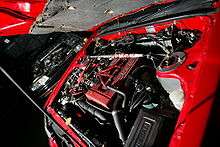Nissan FJ engine

The Nissan FJ series engine was a straight-4 DOHC 2- or 2.4 L internal combustion engine produced by Nissan in the 1980s, in 2.4 L guise as a rally motor for the 240RS, and 2.0 L for general production models. The FJ20 weighs 366 lb (166 kg); the FJ24 weighs 368 lb (167 kg). The 2.0 L variant was used in the US110 and US12 Nissan Silvia/Gazelle/Sakura, and DR30 Nissan Skyline. The 2.4 L variant was used in the Silvia based BS110 Nissan 240RS rally car. While a 1.5 L variant was designed and a prototype built, it never actually went into production. It is acclaimed by some as the forefather of the CA engine.While the DOHC CA head is similar, this is actually unlikely, as the SOHC CA was devised as a lightweight replacement for the L/Z series motors when the FJ first entered production, and the DOHC CA head appeared later when the RB series was released. The FJ has an aluminium head, chain driven cams, and an iron block. Turbo motors were only available in Japan and New Zealand and the non turbo variants were available in Japan, Hong-Kong, Australia and Europe. Datsun enthusiasts like to swap FJ engines into L or Z series powered vehicles. The FJ has similar mounting points to L/Z/KA blocks. It was discontinued in the mid 1980s due to its prohibitive cost.It featured large ports,dual valve-springs and a wide angle bucket on shim valvetrain design similar to other (later) Nissan twincams like the VG, CA, RB, and KA, series DOHC motors and the previous S20 6 cyl DOHC motor from the early 1970s GT-R.
Specifications
These engines were developed before Nissan used the D to denote "double over head cam". The FJ is indeed a DOHC 16 valve design with mechanically actuated cam on bucket follower design. The head is aluminium and the block is iron.
| FJ20E | FJ20ET | FJ20ET With intercooler | FJ24 | |
|---|---|---|---|---|
| Total displacement(cc) | 1990 | ← | ← | 2340 |
| bore×stroke(mm) | 89×80 | ← | ← | 92×88 |
| Compression ratio | 9.1 | 8.0 | 8.5 | 11.0 |
| Max power/(rpm) | 150 PS (110 kW; 148 hp) at 6,000 | 190 PS (140 kW; 187 hp) at 6,400 | 205 PS (151 kW; 202 hp) at 6,400 | 240 PS (177 kW; 237 hp) at 7,200 |
| Max torque(kgf·m at rpm) | 18.5 at 4,800 | 23.0 at 4,800 | 25.0 at 4,400 | 24.0 at 6,000 |
| Max torque at rpm | 181 N·m (133 lb·ft) at 4,800 | 225 N·m (166 lb·ft) at 4,800 | 245 N·m (181 lb·ft) at 4,400 | 235 N·m (173 lb·ft) at 6,000 |
| First use | Oct 1981 DR30 Skyline 2000RS | 1984 (R)S12 Silvia RS-X | Feb 1983 DR30 Skyline 2000RS-Turbo | 1983 S110 240RS |

- The numerical value is gross mark (engine single purpose crankshaft output).
- A part of numerical value is different by Skyline and Silvia/Gazelle.
- There is a version of the FJ24 with 275 PS (202 kW; 271 hp)
FJ20E
Distinguished by the "E" for "Electronic Fuel Injection". Maximum output was 150 PS (110 kW).
The FJ20E was installed in the DR30 Skyline RS, as well as the US110 and S12 Gazelle/Silvia RS.

FJ20ET
"T" denotes turbocharged engine. Maximum output was 190 PS (140 kW) in the R30, and 185 PS (136 kW) in the S12. Boost pressure to achieve this power output was only 6-7 psi. Later intercooled versions produced 205 PS (151 kW) with a slight boost increase.
The FJ20ET was installed in the DR30 Skyline RS/RS-X/RS-X Turbo C and S12 Gazelle/Silvia RS-X; Turbo C versions of the DR30 were intercooled, as well as some S12 RS-X trim cars. The intake plenum chamber was shortened in the S12 compared with the DR30 because of the smaller engine bay and thus produced slightly less torque and power. However the DR30 intake plenum can be fitted to the S12 engine bay with very little clearance. The DR30 FJ20ET also featured a twin scroll exhaust manifold, the S12 received a smaller log style turbo manifold due to lack of firewall clearance.

FJ24
200 or more were produced as a homologation car engine of World Rally Championship at that time according to the Group B regulation. Displacement was expanded to 2,340 cc, though it was actually carburated. The FJ24 was installed in the Nissan 240RS based on the S110 model Silvia. Among 200 total production number, 50 were right-hand drive (RHD), and 150 were left-hand drive, and obtained the Group B recognition of the WRC. 30 were used for the domestic rally championship in the WRC and each country from among the original 200. The number of sales in Japan is uncertain because there was no detailed record, though a small number of people bought the original rally cars. Therefore, development was not done in consideration of domestic exhaust emissions regulations.
Three 240 RS came to Guatemala. Their code numbers were 33D, 16E and 77. They were raced in the Guatemalan and Central American Championships in 1985 and 1986.
